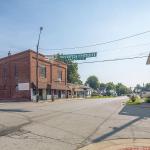“Monrovia, Indiana,” Reviewed: Frederick Wiseman’s Anguished Study of Small-Town America

Documentary isn’t a genre, it’s a principle and a promise, and it gives rise to the same movie genres and types that fiction filmmaking does: romance, melodrama, political thriller, mystery, Western, musical, historical drama, comedy, science-fact, fantasy. Frederick Wiseman’s new documentary, “Monrovia, Indiana,” his forty-fourth feature, which opens Friday at Film Forum, proves the point: he transforms the specifics of his encounters, observations, and analyses of public life in a small Midwestern town into a work of political symbolism. What emerges is a real-life American horror story.
Monrovia is part of an area that voted overwhelmingly Republican in the 2016 election. There’s nothing in the film that indicates as much—not a word or a sign of explicit national or partisan politics. Rather, Wiseman films an area where the population is overwhelmingly white, the setting mainly rural, and the economy largely agricultural. There, he reveals, in its bright open spaces and tranquil streets, the negative weight of an oppressive past, the virtual amber of stifling tradition. This movie about the life of the town is a vision of death in the air; many of its participants come off as virtual posthumous survivors of their own phantom selves.
It’s not a diagnostic film, not one that traces the historical, political, and cultural forces behind the town’s ghostly torpor. Rather, it’s a pre-political—or sub-political—tableau of forces that are pulling the strings of modern life against the rational clarity of collective progress. Yet for all its sense of stifled energy and moral implosion, it’s a calmly analytical film in which—as ever in Wiseman’s work—extended discussions and public debates are developed with an absorbing dramatic power.
There’s a fascinating scene of vast ideological implications early on, at a Bible-study class in a local church, in which the teacher, speaking in a small seminar room to a handful of adult students, focusses his lesson on the subject of “tribulations” as cited in the New Testament and the term’s implications for modern-day believers. His lecture is learned, his tone is personal, his examples are charmingly everyday—yet his interpretation proves to be quietly devastating, as he delivers a doctrine of pain that’s not to be mitigated in life but only in death, and of personal responsibility that’s rather a form of guilt. If life is misery, as he suggests, and people have only themselves to blame, then the very nature of social change is futile and the notion of progress is vanity.
The movie shows young people burdened by the aged and the deceased in a peculiar variety of ways, starting in an institution that has long fascinated Wiseman: high school. He visits a classroom in which a teacher delivers a long, detailed, and deadly lecture about Monrovia’s glorious history of basketball in the early and mid-twentieth century, with a sidebar on its heritage of football. Yet there’s a stinger at the end: the teacher refers to the town’s longtime ritual of midnight football practice, “a family and community thing” that has, he says regretfully, vanished. A theatre group, all girls, rehearses a choreographed version of “Ja-Da” (from 1918); when the movie moves back outside, it visits a display of a model nineteenth-century locomotive.
The absence of political discussion is no mere mark of amiability or local focus but of a terrible disconnection of effects from causes—as when a group of mostly elderly men, gathering in a local café and discussing bypass surgery and the lengthy recovery and therapy on which it depends, don’t share a word about the economic and administrative infrastructure (whether insurance or facilities) on which their treatment depends. Wiseman puts this silence, this absence of discourse, clearly and sharply onscreen by following the men’s discussion with a town-board meeting that’s being addressed by a consultant, who advises its membership (of approximately eight people, men and women, all white) about expanding the tax base, attracting businesses, and creating housing for new employees.
Meetings of the town board are featured in three extraordinary extended sequences in “Monrovia, Indiana,” and the local issues confronted there prove to be distillations of large-scale political conflicts and their bitter, divisive, vindictive terms. All three pit questions of growth against forces seeking to preserve the status quo. In one of them, a resident of a recent housing development, called Homestead, attends the meeting to complain that the fire hydrant on his block turns out to be a mere sham, a dead hydrant; what’s revealed in the course of the discussion is that legal restrictions force the town’s fire company to use tanker trucks instead of hydrants, and that its rejection of a project to create and control its own water supply is largely at fault. What emerges from the thicket of bureaucratic minutiae is the virtual declaration, by longtime Monrovians, that they’ll do nothing but the minimum to keep the newcomers’ homes from burning. In another meeting, another debate over Homestead proves even more bitter, as one board member, opposing the extension of that development, claims that its residents are bringing crime and disorder to the community.
The insularity of long-standing ways and longtime residents emerges in a barrage of exemplary scenes and details. Wiseman captures the solemn joy of a church wedding (at which the wedding singer is a black woman, the only voice of a person of color that’s heard throughout the film), where the minister celebrates the couple’s union with the assembly, on the pulpit, of a “unity cross” that’s deployed to perpetuate traditional gender roles and relations. A Lions Club meeting features a somnolent debate centered around the installation of a second bench where there never was one before; a meeting of a Masonic lodge shows a fifty-year member being honored with a ritual pomp more apt for a funeral.
